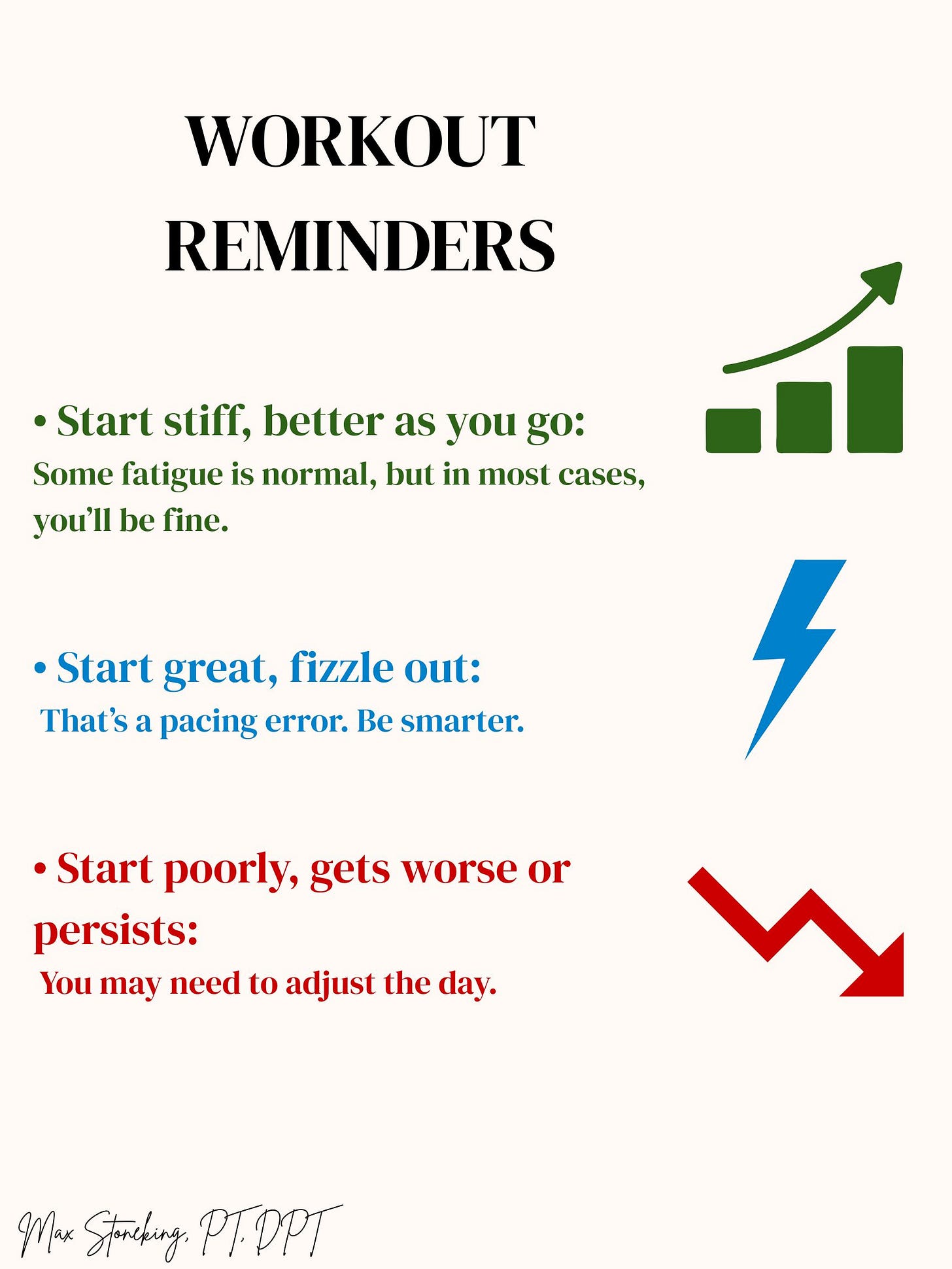Embrace the suck?
Take a rest day?
Change the plans?
If you have been training long enough, you have asked these questions before. It is a normal part of the process. The key, however, is knowing what to do when those thoughts creep in. Are they telling me something?
This week, we talk about—
How to interpret what your body may be feeling
How to make better decisions on whether to press on on hold up
The importance of a solid warmup for races and workouts
We’ll use the following graphic to guide the discussion…
Better as you go
There might be days where you do not feel great getting out the door. Fatigue is not the goal of a training program, but it is a byproduct of working hard. If those feelings dissipate as you get through a run, ride, or swim, you are going to be fine. Some days, loosening up is the goal of the workout. In this case, goal achieved!
Fading from start to finish
There are also days where you charge out the door with a lot of energy, only to finish the session with little energy to spare. Often times, this is a pacing error for the workout. You can ruin a workout with poor pacing or by going hard on a day that is supposed to be more relaxed.
Stick to the plan. Focus on execution.
A true bad day
Finally, there are days that are truly worth reconsidering your plans. If you start out feeling rough and get worse, it may be worth it to opt for something shorter or try again tomorrow. The body keeps score and has a good way of notifying you when something is not right. This does not mean you should avoid pushing through discomfort at the first sign of difficulty. Training should challenge you, but suffering for no reason is foolish.
Consider changing plans if..
You can hardly tick the legs over on an easy day. It sounds silly, but if it is a low intensity day, but you stick it out for the whole session feeling like it is hard, you missed the point.
There is major disconnect between your expected paces/power and what you can offer that day
There is injury-like pain associated with these poor feelings
Live to fight another day.
Warmups
Odd sensations in workouts can be a result of a poor warmup and can be the difference between a good and bad performance. It is important to find what works for you. Everyone is going to be different when it comes to warming up and you may even use a different warmup for different types of races.
Some general warmup guidelines
Don’t try to win the warmup
That’s not the competition. Get the muscles and lungs firing, but save your main mojo.
Ease into it
A slow and steady build of 10-15 minutes is a good place to start for many races or workouts
Insert some pep
To avoid that “shock” to the body that can come at the start of a race or hard interval, you can use some short strides, spin ups, or sprints depending on your event. 3-5 x 30 seconds working at or above race pace can get the system firing. Again, this is merely an example.
It should also be noted that the warmup can provide mixed signals for what is to come. I have had plenty of workouts and even races where my warmup was, for lack of a better word, crap, but then I had a respectable performance. It does not always predict how you will perform.
With that said, trust your warmup. Do it with intent. Don’t overthink how you are feeling.
If it is a race, you’re stuck with what you have got. Don’t bail from the start line just because the warmup went poorly.
If it is a workout, pay attention to how the feelings persist or fade once you get rolling. As we saw above, you may come good and keep chugging or you may be destined for calling it a day.
Skipping a warmup entirely because it has poor predictive value is not a good reason. Most of the time, it works out.
There are decisions to be made sometimes in training. You are not a robot where every day is on autopilot.
Listen to what the body says. Be sensible. Set the tone with a consistent warmup.


